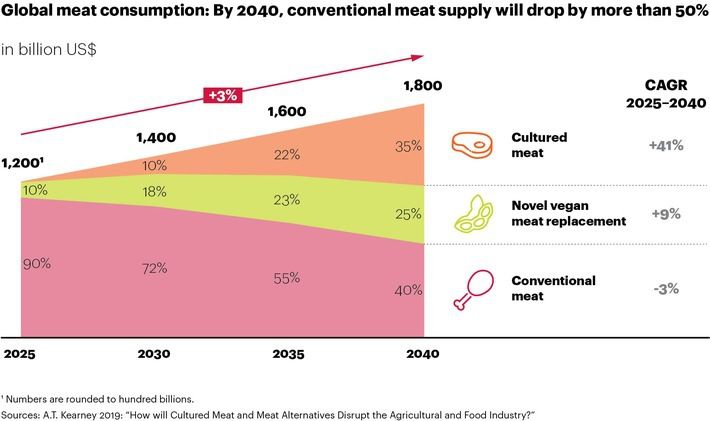Animal meat disappears from the shelves
New alternatives are whirling the agricultural and food industries upside down
A.T. Kearney Study on the Future of the Meat Market until 2040

Development of meat consumption until 2040.
A.T. Kearney
"We are facing nothing less than the end of meat production as we know it," predicts Dr. Carsten Gerhardt, partner and agricultural expert at A.T. Kearney. "By 2040, only 40 percent of meat products consumed will come from animals." This meant also a shrinking of the mass animal husbandry with all its problems.
Gerhardt refers to a new study by the international management consultancy entitled "How will Cultured Meat and Meat Alternatives disrupt the Agricultural and Food Industry?", which deals intensively with new alternatives to classic meat products. Although the authors assume that the global meat market will continue to grow overall, new meat alternatives and cultivated meat are increasingly replacing ordinary meat.
New, vegan meat alternatives and cultivated meat are impressive in many respects and their properties could make an important contribution to climate protection and resource conservation. Their conversion rate from plant calories to meat calories is about four times better than that of traditional meat because their production is much more targeted to the final meat product and involves less energy loss. The land and fertiliser problems are reduced and the use of antibiotics and other substances for the rearing and protection of animals is eliminated.
The agricultural expert also sees great economic opportunities and a radical change in the food industry in view of completely new business models and supply chains. In his opinion, the current market entry of "Beyond Meat" and the associated media hype is only the beginning. The global meat market will grow from around 1,000 billion US dollars annually to around 1,800 billion by 2040. However, as the cards are being shuffled from scratch, it is not surprising that many investors are investing massively in new approaches. By 2018 alone, around 950 million US dollars had flowed into start-ups. Of this, 50 million US dollars were invested in the comparatively young idea of producing meat by cell proliferation and structuring without killing an animal.
Note: This article has been translated using a computer system without human intervention. LUMITOS offers these automatic translations to present a wider range of current news. Since this article has been translated with automatic translation, it is possible that it contains errors in vocabulary, syntax or grammar. The original article in German can be found here.
Most read news
Other news from the department business & finance

Get the food & beverage industry in your inbox
By submitting this form you agree that LUMITOS AG will send you the newsletter(s) selected above by email. Your data will not be passed on to third parties. Your data will be stored and processed in accordance with our data protection regulations. LUMITOS may contact you by email for the purpose of advertising or market and opinion surveys. You can revoke your consent at any time without giving reasons to LUMITOS AG, Ernst-Augustin-Str. 2, 12489 Berlin, Germany or by e-mail at revoke@lumitos.com with effect for the future. In addition, each email contains a link to unsubscribe from the corresponding newsletter.





























































